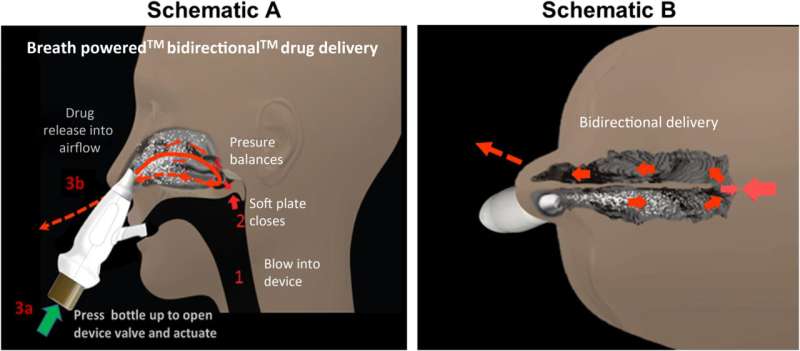This article has been reviewed according to Science X's editorial process and policies. Editors have highlighted the following attributes while ensuring the content's credibility:
fact-checked
trusted source
proofread
'Exhalation' system improves symptoms for most common form of chronic sinus infections

An exhalation delivery system that uses a patient's own breath to carry the anti-inflammatory compound fluticasone (EDS-FLU) directly to the sinuses reduces chronic sinus infection (sinusitis) symptoms and decreases aggravations and infections associated with chronic inflammation of the sinus by more than 50 percent, researchers from the Perelman School of Medicine at the University of Pennsylvania reported.
The randomized, international clinical trials (NCT03781804 and NCT03960580), published today in The Journal of Allergy and Clinical Immunology: In Practice, compared EDS-FLU to a placebo in more than 500 adults with chronic rhinosinusitis with or without nasal polyps.
Patients used either EDS-FLU or a placebo twice daily for 24 weeks. EDS-FLU works through a patient exhaling into the device to send the medication deep into the far reaches of their sinus cavities, where the topical medication is most effective. Compared to a placebo, sinus symptom scores and CT scan results were significantly improved.
Symptoms of nasal congestion, nasal discharge, facial pain/pressure, and loss of smell improved dramatically with EDS-FLU compared to placebo, as measured by the sinonasal outcome test-22, a standardized scoring measure for sinonasal symptoms.
"Chronic sinusitis affects as much as 10 percent of the United States population and can make breathing uncomfortable and negatively impact a person's daily life," said lead author James N. Palmer, MD, the David W. Kennedy, MD Endowed Professor of Otorhinolaryngology and director of Rhinology at Penn Medicine. "These findings provide strong evidence for an effective, non-invasive treatment option for people who continue to experience symptoms after over-the-counter medications have failed."
Millions of Americans experience the symptoms of chronic sinus infections and inflammation, a largely inflammatory condition that causes nasal congestion, sinus pressure, and pain when the sinus membranes are inflamed for long periods of time. Although over-the-counter nasal sprays offer marginal relief, no FDA-approved medication exists for the most common form of the condition, chronic rhinosinusitis without nasal polyps, known as "chronic sinusitis."
While some nasal sprays may offer some symptom relief, patients who were using a standard-delivery nasal spray before study enrollment still reported similar improvements in symptoms compared to others in the study. These are the first placebo-controlled clinical trials to show that medication reduces subjective symptoms and objective measures of sinus disease for patients with chronic sinusitis, both with and without polyps.
Currently, patients whose symptoms are not resolved by over-the-counter nasal sprays or other medications have limited options for relief, including antibiotics, surgery, or—for patients with nasal polyps—lifelong biologic therapies.
EDS-FLU was determined to be as safe as standard over-the-counter nasal sprays.
More information: James N. Palmer et al, Efficacy of EDS-FLU for Chronic Rhinosinusitis: Two Randomized Controlled Trials (ReOpen1 and ReOpen2), The Journal of Allergy and Clinical Immunology: In Practice (2024). DOI: 10.1016/j.jaip.2023.12.016



















